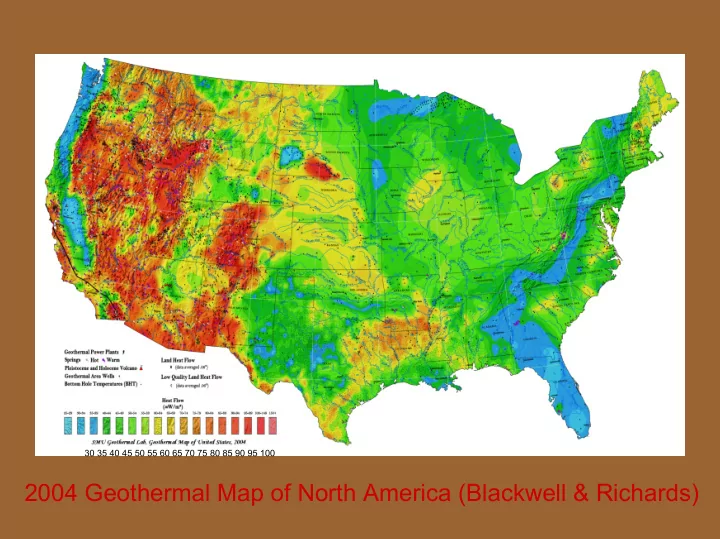

30 35 40 45 50 55 60 65 70 75 80 85 90 95 100 2004 Geothermal Map of North America (Blackwell & Richards)
All data sites for US heat flow map including sites of wells with BHT data in the AAPG data base. BHT symbols are based on depth and temperature. The named wells are the BHT calibration points . Heat flow and BHT sites
CALCULATION OF TEMPERATURE AT DEPTH Input values : Surface heat flow (Q 0 ), Mantle heat flow (Q m ), Thermal conductivity for sediments (K s ), Sediment thickness (X S ), Surface temperature (T 0 ), Surface sediments (A s ), Surface basement (A b ), Radioactive layer (r). Sediment Contribution Basement Contribution x − b − 1 2 Q e r Q X X = − 2 = − m 0 T A r S S T A b b S S K K K K b b S S Where A s =1 µ W/m 3 Where A b =( Q below_sediments -Q m )/ r Flow chart for calculation Temperature at depth of temperature and heat T=T s +T b content at depth. Note: 1 kW-sec = 1 Correct for surface temperature kJ and angle brackets T final =T+T 0 denote depth-averaging. For 3 and 4 km K s was from BHT data; below 4km K S =K b =2.6; For most of the U.S. r = 10 km. If sediment thickness exceeds 3 km then r = 13-X S (Sediment thickness) [ ] [ ] = ρ ∆ = ρ − Q C V T C V T T i p i i p i sgw
Sediment thickness map (in meters, modified from AAPG Basement Map of North America, 1978). The 4 km depth contour is outlined with a bold black line. Low-conductivity regions in the western United States are in blue/green.
Mantle Heat Flow 60 mW/m 2 4 °C 6 °C 8 °C 10 °C 12 °C 14 °C 16 °C 18 °C 20 °C 22 °C 24 °C 26 °C Map of surface temperature (colors, Gass, 1982) and generalized mantle heat flow for the conterminous US (dotted area inside heavy black line is greater than 60 mW/m 2 , the remainder of the area is 30 mWm 2 )
Surface Gradient
Temperatures at 4.5, 6.5 and 10 km Depths
Temperatures at depths of 2 to 5 km in The Geysers/ Clear Lake thermal area (Erkan et al., 2005)
1,000,000 EJ 10,000 x US use Estimated total geothermal resource base and recoverable resource given in EJ or 10 +18 Joules.
Histograms of heat content in EJ, as a function of depth for 1 km slices.
Histograms of US area at a given temperature, as a function of depth for 1 km slices.
Table 1.1 Estimated U.S. geothermal resource base to 10 km depth by category Category of Resource Thermal Energy, in Reference Exajoules (1EJ = 10 18 J) Conduction-dominated EGS Sedimentary rock formations >100,000 This study Crystalline basement This study rock formations 13,900,000 Supercritical Volcanic EGS* 74,100 USGS Circular 790 2,400 – 9,600 USGS Circulars 726 and 790 Hydrothermal 0.0944 – 0.4510 McKenna, et al. (2005) Coproduced fluids 71,000 – 170,000** USGS Circulars 726 and 790 Geopressured systems * Excludes Yellowstone National Park and Hawaii ** Includes methane content Remember 100 EJ =US 1 year use
OVERTON FIELD, EAST TEXAS (COTTON VALLEY TIGHT GAS SANDS) Learning Curve Example Improved Drilling and Production Results • Reduced drilling time by 50%. • Increased initial production by three fold. • Increased EUR per/well by 60%. 2000 FINA Avg – 55 Days SOUTHWESTERN ENERGY COMPANY
Installed Capacity -- 980,000 MW (EIA) ~100 EJ (10,000 MW)
Coproduced Geothermal Energy Potential
Pleasant Bayou, Texas Gas Engine(500 kW, above); Binary Turbine (500 kW, left)
Texas Gulf Coast Geopressure Fairways Depth to Geopressure in Km And Fairway locations
100 MW Sustainable EGS Development in Tight Gas Sands in East Texas and Northern Louisiana
Renewable Portfolio Standards MN: 10% by 2015 Goal + VT: RE meets load Xcel mandate of growth by 2012 1,125 MW wind by 2010 ME: 30% by 2000 MT: 15% by 2015 WI: requirement varies by MA: 4% by 2009 + utility; 10% by 2015 Goal 1% annual increase RI: 15% by 2020 CT: 10% by 2010 ☼ NY: 24% by 2013 CA: 20% by 2010 IA: 105 MW ☼ NJ: 20% by 2020 IL: 8% by 2013 ☼ NV: 20% by 2015 ☼ CO: 10% by 2015 ☼ PA: 18%¹ by 2020 *MD: 7.5% by 2019 *DE: 10% by 2019 ☼ AZ: 1.1% by 2007 ☼ DC: 11% by 2022 *NM: 10% by 2011 TX: 5,880 MW by 2015 State RPS HI: 20% by 2020 State Goal ☼ Minimum solar or customer-sited requirement * Increased credit for solar ¹PA: 8% Tier I, 10% Tier II (includes non-renewable sources) DSIRE: www.dsireusa.org April 2006
Recommend
More recommend